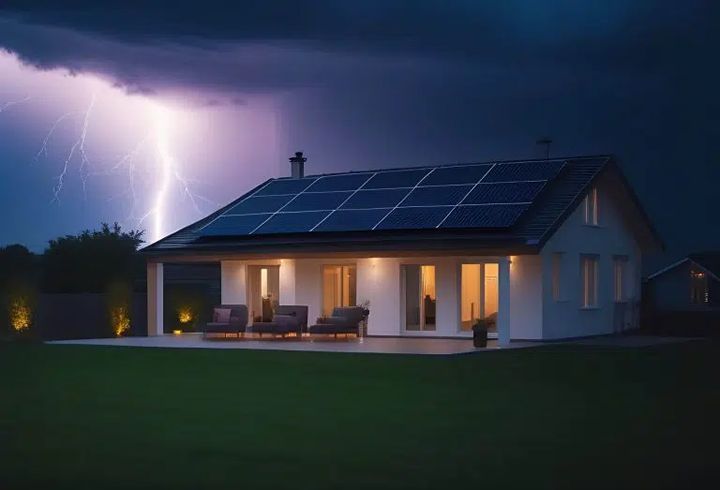EMPs can severely damage electronic devices and disrupt power supplies. EMP hardening offers a safeguard, especially for residential hybrid inverters like the Sol-Ark 15K-2P Whole Home hybrid inverter.
 The Impact of EMP Hardening on Solar Hybrid Inverters
The Impact of EMP Hardening on Solar Hybrid Inverters

Article from | Sol-Ark
As renewable and solar energy systems continue to grow in popularity among residential homeowners, many are looking for ways to protect their systems from emerging threats like electromagnetic pulse (EMP) events. EMPs can severely damage electronic devices and disrupt power supplies. EMP hardening offers a safeguard, especially for residential hybrid inverters like the Sol-Ark 15K-2P Whole Home hybrid inverter. Beyond helping reduce the impacts of EMPs, is understanding if EMP hardening effects the performance, efficiency, lifespan, and reliability of solar hybrid inverters.
EMP 101: What is EMP and EMP Hardening?
An electromagnetic pulse (EMP) is a burst of electromagnetic radiation that can result from natural sources like solar flares or man-made sources such as nuclear detonations. EMPs generate intense electric fields that can damage or disrupt electronic components by overwhelming their circuits with a sudden surge of energy (Federal Emergency Management Agency [FEMA], 2021).
EMP hardening refers to the process of designing and reinforcing electronic equipment to withstand these pulses, ensuring that crucial systems, like residential solar energy setups, remain functional even after an EMP event.
EMP Hardening Impact on Inverter Performance
The Sol-Ark Whole Home Hybrid Inverter EMP hardening enhances resilience without significantly impacting the system’s overall performance. Since EMP protection primarily involves shielding sensitive components and adding surge protection mechanisms, the inverter’s power output, response times, and energy conversion efficiency are generally unaffected (U.S. Department of Energy [DOE], 2022).
Homeowners can expect an EMP-hardened inverter to perform similarly to a non-hardened model in terms of regular operational performance, with the added benefit of protection from EMP threats. For solar installers, this means explaining any added installation steps as well as benefits to homeowners, emphasizing that these modifications do not detract from the inverter’s core functionality.
Efficiency and Energy Management
The efficiency of an EMP-hardened inverter is comparable to that of standard inverters. EMP hardening involves measures like surge protection, which are not active components during regular energy conversion but activate only when an EMP event occurs. These protective features ensure that the inverter continues to manage energy flows between solar panels, battery storage, and home appliances without unnecessary loss of efficiency (National Renewable Energy Laboratory [NREL], 2021).
Inverters like the Sol-Ark 15K-2P have been engineered with efficiency in mind, boasting high efficiency ratings even with EMP protection. Homeowners retain the system’s ability to maximize energy capture and storage without compromising on daily operational efficiency.
EMP Hardening on Lifespan and Durability
An EMP-hardened inverter is generally more durable than a non-hardened one due to its reinforced components and surge protection mechanisms. These additional protective elements reduce the likelihood of critical component failure during an EMP event, which indirectly extends the inverter’s overall lifespan (Electromagnetic Pulse Resilience Study, 2023).
While the EMP hardening itself does not directly increase lifespan under regular conditions, it does ensure the inverter will likely survive otherwise catastrophic events, providing a longer functional life in environments where EMP risk is present. For homeowners, this means peace of mind and a lower risk of costly replacements or repairs due to EMP-related damage.
Reliability in Extreme Conditions
The Sol-Ark 15K-2P includes features like EMP-resistant surge protection and shielding, which activate instantly when an EMP is detected (DOE, 2022). This ensures that homeowners retain access to power when it is most critical, especially in cases where EMPs could disrupt grid-based electricity. For households in remote or disaster-prone areas, EMP hardening offers an added layer of security, ensuring uninterrupted power for essential devices.
EMP Hardening Standards and Certifications
There are no universally mandated EMP hardening standards for residential solar systems; however, the U.S. Department of Defense (DoD) has established guidelines that influence industry practices. For example, MIL-STD461-G, developed for military applications, outlines standards for EMP protection that many manufacturers reference when designing hardened products (DoD, 2021). While these standards are more rigorous than what is required for residential applications, they serve as a reference for quality. The Sol-Ark 15K-2P meets and exceeds the MIL-STD461-G standard; download the certification.
EMP hardening in hybrid inverters like the Sol-Ark 15K-2P brings distinct advantages to residential solar energy systems. While EMP protection adds upfront costs, it provides significant benefits, including enhanced durability, reliability, and longevity, without sacrificing performance or efficiency. As EMP resilience technology continues to advance, EMP-hardened inverters will likely become a standard feature in residential solar systems, offering robust protection for the homes of the future.
References
- Department of Defense. (2021). MIL-STD-188-125: High-Altitude Electromagnetic Pulse (HEMP) Protection for Fixed and Transportable Ground-Based Systems. U.S. Department of Defense.
- Department of Energy. (2022). Protecting Critical Infrastructure: Resilience to EMP Events. U.S. Department of Energy.
- Federal Emergency Management Agency. (2021). Electromagnetic Pulse (EMP) and Protecting Critical Infrastructure. Federal Emergency Management Agency.
- National Renewable Energy Laboratory. (2021). The Impact of EMP on Renewable Energy Systems. National Renewable Energy Laboratory.
- Solar Energy Industries Association. (2023). Best Practices for EMP-Resistant Solar Equipment. Solar Energy Industries Association.
The content & opinions in this article are the author’s and do not necessarily represent the views of AltEnergyMag
Comments (0)
This post does not have any comments. Be the first to leave a comment below.
Featured Product

